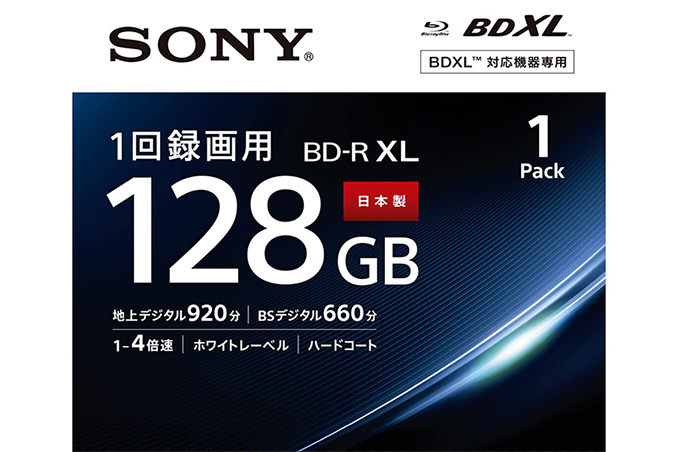Sony Releases Quad-Layer 128 GB BD-R XL Media
by Anton Shilov on November 9, 2018 1:00 PM EST
Sony is about to start selling the industry’s first 128 GB write-once BD-R XL optical media. The discs will also be the first quad-layer BDXL media formally aimed at consumers, but bringing benefits to professionals that use BDXL today.
Although the general BDXL specifications were announced back in 2010 for multi-layered write-once discs with 25 GB and 33.4 GB layers, only triple-layer BDXL discs with a 100 GB capacity (generally aimed at broadcasting, medical, and document imaging industries) have been made available so far. By contrast, quad-layer 128 GB media has never seen the light of day until now.
As it turns out, increasing the per-layer capacity of Blu-ray discs (BDs) to 33.4 GB via a technology called MLSE (Maximum Likelihood Sequence Estimation) was not a big problem, and most of today’s BD players and optical drives support the BDXL standard. However, increasing the layer count to four while ensuring a broad compatibility, signal quality across four layers, yields, and some other factors slow downed release of 128 GB BDXL essentially by eight years.
In a bid to build a viable quad-layer 128 GB write-once BDXL disc, Sony had to design three new materials. First, the company had to create a new recording alloy that would provide the right combination of reflectance and transmittance to ensure that the layers can “reflect” data bits when needed while allowing the 405nm laser to pass through them when another layer is accessed. Then, Sony had to develop a new inter-layer material (called dielectric) that would also be able to transmit light waves. Finally, because with four layers the first one has to be located closer to the disc’s surface, Sony had to design a new protective coating for the media.
Sony will start shipments of its BD-R XL 128 GB media on the 10th of November. Single-disc packages (BNR4VAPJ4) will retail for ¥1,500 ($13), a pack of three (3BNR4VAPS4) will cost ¥3,900 ($34), whereas a pack of five (5BNR4VAPS4) will be priced at ¥6,000 ($53). The discs should be compatible with drives supporting the BDXL spec, though a firmware update may be needed regardless.
Related Reading:










44 Comments
View All Comments
xiaohongshu - Sunday, May 1, 2022 - link
With the pandemic, life is difficult, EVERYWHERE0ldman79 - Tuesday, November 13, 2018 - link
Sammiches25 is correct.If you don't go by the idiotic maps that count LTE as a true broadband service, a huge chunk of the population in the US doesn't have true Internet service.
I'm sorry, I don't count a service with a 20GB cap as the baseline as a real Internet service. It is a fixed spectrum with fixed capacity. The data caps serve a purpose, but that capacity limit is what prevents LTE from being an actual solution.
Geographically, most of the USA doesn't have adequate service, population wise I think it's like 33% doesn't.
bunnyfubbles - Saturday, November 10, 2018 - link
https://en.wikipedia.org/wiki/Sneakernethigh latency, sure, but potentially competitive throughput, also arguably more secure
SigmundEXactos - Friday, November 9, 2018 - link
And I guess 128GB memory cards are closer to $20. But I wonder what the longevity of one vs the other is? And transfer rates between the two?neblogai - Friday, November 9, 2018 - link
Also, how safe memory cards are if a huge electromagnetic storm were to happen?PeachNCream - Friday, November 9, 2018 - link
Those are infrequent events. Sure, there is a balance of cost versus data security, but how many geomagnetic storms with global consequences have there been in recorded history?UkeNeverSeme - Friday, November 9, 2018 - link
Once. Pretty much. In the 19th century. Was a pretty big deal, auroras in Cuba and whatnot. The supposed rate of solar events that large is one every 500 years.Ryan Smith - Friday, November 9, 2018 - link
"But I wonder what the longevity of one vs the other is? And transfer rates between the two?"BD-Rs, especially those designed as archival grade, can last anywhere between 50 and 150 years depending on the disc. SSDs, on the other hand, are generally only rated for 10 years at the most, with the cheapest TLC-based storage bringing up the rear.
Transfer rates are a toss-up. BD-R recording isn't especially fast, but at the edges you're looking at around 70MB/sec. There are TLC-based drives out there that are certainly slower than this. But drives built closer to true SSD standards can definitely sustain over 70MB/sec.
CiccioB - Friday, November 9, 2018 - link
In reality with new shrinked flash memory in the 1Y class, the retention time without power connection is limited to some months.Flash memory IS NOT A RELIABLE MEDIA TO STORE DATA FOR A LONG TIME!
Use standard magnetic HDD if you do not want to use optical discs or tapes. Though even HDD have the problem that can suddenly broke down (so you need a double copy on a different disk, so storage cost doubles).
Optical disks are and remain the cheapest and most reliable media for long time storage/backups.
That's why industry still invest in them though in consumer market all are about flash here and flash there which is undoubtedly faster but that with shrinking multi level cells and thus higher error rate to be corrected with ever more complex algorithm, it is more a game of probability than of secure data write/read, something I will never trust for my data to be stored permanently (or for a long time).
I hope the new 3D Xpoint technology will soon be available at decent costs so to completely replace flash memory technology.
jeremyshaw - Saturday, November 10, 2018 - link
Lol. 3D Xpoint only has about 3 months of power-off retention.